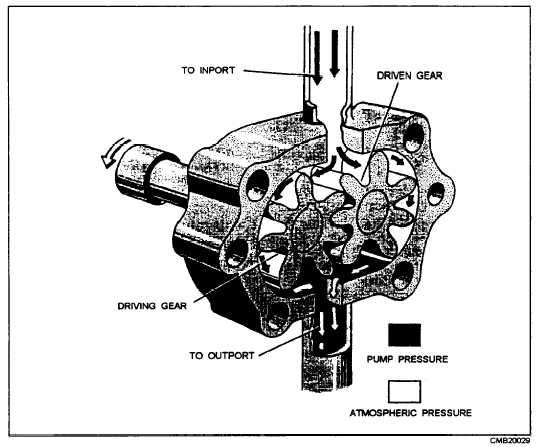
Figure 3-7. - Gear-type rotary pump.
to minimize slippage from the discharge side back to the suction side. They are designed to operate at relatively moderate speeds. Operating at high speeds causes erosion and excessive wear which results in increased clearances.
There are numerous types of rotary pumps and various methods of classification. They may be classified by shaft position - either vertically or horizontally mounted; the type of drive - electric motor, gasoline engine, and so forth; their manufacturer's name; or service application. However, classification of rotary pumps is generally made according to the type of rotating element.
RECIPROCATING PUMPS. - The term reciprocating is defined as back-and-forth motion. In a reciprocating pump, it is the back-and-forth motion of pistons inside of cylinders that provides the flow of fluid. Reciprocating pumps, like rotary pumps, operate on the positive principle; that is, each stroke delivers a definite volume of liquid to the system.
The most common type of reciprocating pump is the hand pump (fig. 3-13). There are two types of manually operated reciprocating pumps - single action and double action. The single-action pump provides flow during every other stroke, while the double-action provides flow during each stroke. Single-action pumps are frequently used in hydraulic jacks.
Several types of power-operated hydraulic pumps, such as the radial piston (fig. 3-14) and axial piston (figs. 3-15 and 3-16), are classified as reciprocating pumps. These pumps are sometimes classified as rotary pumps, because a rotary motion is imparted to the pumps by the source of power. However, the actual pumping is performed by sets of pistons reciprocating inside sets of cylinders.
Control Valves
It is all but impossible to design a practical fluid power system without some means of controlling the volume and pressure of the fluid and directing the flow of fluid to the operating units. This is accomplished by incorporating different types of valves. A valve is defined as any device by which the flow of fluid may be started, stopped, or regulated by a movable part that opens or obstructs passage.
Continue Reading